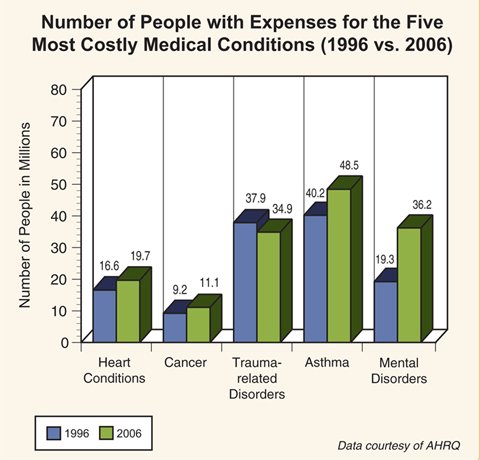
CATHERINE RAMPELL
Dollars to doughnuts.
As I write in a magazine column this week, mental illness costs the country a lot of money, primarily in indirect costs like lost worker productivity and increased use of the social safety net. That is one argument for why it might be cost-effective to increase national spending on the direct costs of treatment (like therapy, drugs, etc.).
And there does seem to be some room for increasing spending on mental health care; so far, anyway, the United States has not had the same problem with out-of-control mental health treatment costs that has been seen with other kinds of medical spending.
Mental health spending, both public and private, was about $150 billion in 2009, more than double its level in inflation-adjusted terms in 1986, according to a recent article in Health Affairs. But the overall economy also about doubled during that time. As a result, direct mental health spending has remained roughly 1 percent of the economy since 1986, while total health spending climbed from about 10 percent of gross domestic product in 1986 to nearly 17 percent in 2009.
 Source: Katharine R. Levit, Tami L. Mark, Rosanna M. Coffey, Sasha Frankel, Patricia Santora, Rita Vandivort-Warren and Kevin Malone, “Federal Spending on Behavioral Health Accelerated During Recession as Individuals Lost Employer Insurance,” Health Affairs, 32, No. 5 (2013).
Source: Katharine R. Levit, Tami L. Mark, Rosanna M. Coffey, Sasha Frankel, Patricia Santora, Rita Vandivort-Warren and Kevin Malone, “Federal Spending on Behavioral Health Accelerated During Recession as Individuals Lost Employer Insurance,” Health Affairs, 32, No. 5 (2013).
These numbers might seem particularly surprising given greater awareness of mental health care and higher take-up rates for it. Here is a chart, from the National Institute of Mental Health, showing the number of Americans who had any expenses associated with any of the five most costly medical conditions in 1996 versus 2006:
 National Institute of Mental Health. AHRQ stands for Agency for Healthcare Research and Quality.
National Institute of Mental Health. AHRQ stands for Agency for Healthcare Research and Quality.
As you can see, the fastest growth has been for those with mental disorders, and in 2006, more Americans had expenses for care related to mental disorders than for any other medical condition except for asthma.
Now here is a chart from the same source showing the average expenditures per person associated with each of those five most costly medical conditions, in inflation-adjusted terms:
 National Institute of Mental Health. AHRQ stands for Agency for Healthcare Research and Quality.
National Institute of Mental Health. AHRQ stands for Agency for Healthcare Research and Quality.
For most medical conditions, costs per person have gone up, but for mental disorders and heart conditions, they have fallen slightly.
So what is holding costs down? One explanation has to do with the patent system. A number of blockbuster psychiatric drugs like Prozac lost their patent protection in the early 2000s, which has helped slow growth in the costs of treatment per patient for many mental illnesses. The Health Affairs article also mentions that shortages of inpatient hospital beds in some areas may have helped slow spending growth for inpatient services as well.
In any case, while costs have been relatively controlled, a larger share is being borne by the public sector rather than the private sector, according to the Health Affairs article. In 1986, 43 percent of all mental health spending came from private sources (like patients or private insurance companies); as of 2009, that share had fallen to 40 percent. The cost shift primarily occurred from 2007 to 2009, the years of the recession, as people lost their private insurance and went onto federal programs like Medicaid.
The cost shift from private to public payers has been even greater for overall health spending, of which 59 percent was paid by private sources in 1986 versus 51 percent in 2009.
Article source: http://economix.blogs.nytimes.com/2013/07/02/most-u-s-health-spending-is-exploding-but-not-for-mental-health/?partner=rss&emc=rss